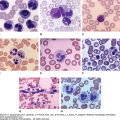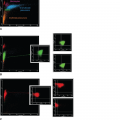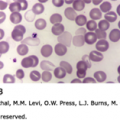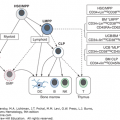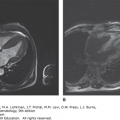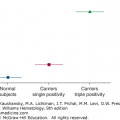INTRODUCTION
SUMMARY
Diffuse large B-cell lymphomas (DLBCLs) comprise a heterogeneous group of aggressive malignancies of large, transformed B lymphocytes.* DLBCL is the most common lymphoma in the world and accounts for approximately 25 to 30 percent of lymphoma cases in the United States. The incidence increases with age, with a median age at presentation in the sixth decade. The disease typically presents as a rapidly growing mass that may involve either lymph node or extranodal sites, and often is associated with systemic symptoms. Approximately 50 to 60 percent of patients will present with advanced stage, disseminated disease. DLBCL is curable with combination chemotherapy. For localized disease, either three cycles of rituximab, cyclophosphamide, doxorubicin, vincristine, and prednisone (R-CHOP) plus involved-field radiation therapy or six cycles of (R-CHOP) is recommended, whereas for advanced stage DLBCL, six cycles of R-CHOP is appropriate. A large phase III intergroup trial testing whether a novel infusional regimen consisting of dose-adjusted rituximab, etoposide, prednisone, vincristine, cyclophosphamide, and doxorubicin (DA-R-EPOCH) is superior to standard R-CHOP has been completed, but the results not yet reported as of this writing. High-dose chemotherapy with autologous stem cell transplantation may be curative for patients with DLBCL that relapses after treatment with frontline chemotherapy.
Acronyms and Abbreviations
ABC, activated B-cell–like; ACVBP, doxorubicin (Adriamycin), cyclophosphamide, vindesine, bleomycin, prednisone; allo-HSCT, allogeneic hematopoietic stem cell transplantation; ASCT, autologous stem cell transplantation; BEAM, high-dose carmustine, etoposide, cytarabine, and melphalan; CHOP, cyclophosphamide, doxorubicin, vincristine, prednisone; CR, complete remission; CytaBOM, cytarabine, bleomycin, vincristine, methotrexate (with leucovorin rescue); DFS, disease-free survival; DLBCL, diffuse large B-cell lymphoma; EBV, Epstein-Barr virus; EFS, event-free survival; EPOCH, etoposide, prednisone, vincristine, cyclophosphamide, doxorubicin; ESHAP, etoposide, methylprednisolone, cytarabine, cisplatin; FDG, 18-fluorodeoxyglucose; GCB, germinal center B-cell–like; GELA, Group d’Etude des Lymphomes de l’Adulte; GVHD, graft-versus-host disease; ICE, ifosfamide, carboplatin, etoposide; IFRT, involved-field radiation therapy; Ig, immunoglobulin; LDH, lactate dehydrogenase; MACOP-B, high-dose methotrexate, doxorubicin, cyclophosphamide, vincristine, prednisone, bleomycin; m-BACOD, moderate-dose methotrexate, bleomycin, doxorubicin, cyclophosphamide, vincristine, dexamethasone; MOPP, mechlorethamine, vincristine, procarbazine, prednisone; OS, overall survival; PFS, progression-free survival; ProMACE, prednisone, methotrexate, doxorubicin, cyclophosphamide, etoposide; PTLD, posttransplantation lymphoproliferative disorder; R-CHOP, rituximab plus CHOP; R-EPOCH, rituximab plus EPOCH; R-ICE, rituximab plus ICE; VACOP-B, vincristine, doxorubicin, cyclophosphamide, etoposide, prednisone, and bleomycin; WHO, World Health Organization.
*This chapter contains elements from the chapter in the 8th edition of Williams Hematology written by Michael Boyiadzis and Kenneth A. Foon.
DEFINITION AND HISTORY
Diffuse large B-cell lymphomas (DLBCLs) comprise a heterogeneous group of aggressive malignancies of large, transformed B cells which cause diffuse effacement of the normal lymph node structure. DLBCL has masqueraded under a variety of colorful but misleading monikers in early lymphoma classification systems, including “reticulum cell sarcoma,” and “diffuse histiocytic lymphoma,” as described in an excellent recent review of the history of the lymphomas.1 Distinct disease entities are distinguished based on morphologic, biologic, and clinical features as established by an international panel of experts on behalf of the World Health Organization (WHO, Table 98–1).2 The disease can arise de novo or may transform from an indolent lymphoma, such as small lymphocytic lymphoma or follicular lymphoma.
|
EPIDEMIOLOGY
DLBCL is the most common B-cell lymphoid neoplasm in the United States and Europe and accounts for approximately 28 percent of all mature B-cell lymphomas.3,4 Incidence varies by ethnicity, with Americans of European descent being more likely to develop DLBCL than Americans of African descent. Like most other lymphomas, there is a male predominance. The disease most commonly presents in late middle-aged and older persons with a median age at diagnosis of approximately 65 years. Because lymphoma incidence rates increased dramatically from the 1940s to the 1990s, numerous exogenous factors have been examined to ascertain if one or more play a role in pathogenesis of the disease, including herbicides (e.g., phenoxyacids), pesticides (e.g., organochlorines), organic solvents (e.g., toluene, benzene), dark hair dyes, body mass index, tobacco use, alcohol use, and inflammatory states. At this time, no inhalant, exposure, or ingestant has been unequivocally proven to increase the relative risk of DLBCL.5
ETIOLOGY AND PATHOGENESIS
DLBCL is a molecularly heterogeneous disease with multiple complex chromosomal translocations and genetic abnormalities as identified by cytogenetics, gene expression profiling, and whole-genome sequencing. The disease is derived from B cells whose immunoglobulin (Ig) genes have undergone somatic mutation in the lymph node germinal center.6 Approximately 40 percent of cases in immunocompetent hosts and approximately 20 percent of HIV-related cases display BCL6 rearrangements.7,8,9 Chromosomal translocations involving band 3q27 lead to a truncated BCL6 gene within its 5′ flanking region. Such truncations commonly occur within the first exon or first intron, leading to complete removal or truncation of the promoter sequences; the coding sequence is left intact.10 In a small number of cases, the breakpoint is not located in the immediate proximity of the BCL6 gene. Increased expression of BCL6 occurs from a process termed promoter substitution by which heterologous promoters are juxtaposed to the BCL6 coding domain. This process occurs through reciprocal translocations between 3q27 and chromosomal partner sites, including 14q32 (IgH), 2p11 (Igκ), and 22q11 (Igλ).10,11 The BCL6 protein mediates the specific binding of several transcription factors to DNA. It also may be involved in induction of germinal-center-associated functions, as it is expressed in germinal center B cells but not in plasma cells. Therefore, downregulation of BCL6 may be necessary for terminal differentiation of B cells to memory B cells and plasma cells.12
Approximately 30 percent of DLBCLs possess a t(14;18) translocation involving the Ig heavy-chain gene and BCL2. Such BCL2 gene rearrangements occur in DLBCL in either of two circumstances: (1) in DLBCLs arising by histologic transformation of a previous follicular lymphoma or (2) in de novo DLBCLs with a germinal center gene-expression profile. The presence of a p53 mutation in combination with BCL2 denotes that the tumor is derived from a histologic transformation of a prior follicular lymphoma.13
Normally, mutations in the variable region of the Ig genes confer antibody diversity in germinal center B cells. However, aberrant somatic hypermutation occurs in more than 50 percent of cases of DLBCL. Such alterations target multiple loci, including the protooncogenes PIM1, MYC, RhoH/TTF (ARHH), and PAX5.11 The c-MYC gene rearrangement occurs in 10 percent of patients with DLBCL.
Gene-expression profiling studies have distinguished three molecular subtypes of DLBCL known as (1) germinal center B-cell–like (GCB), (2) activated B-cell–like (ABC), and (3) primary mediastinal B-cell lymphoma (PMBCL).14,15,16,17 GCB DLBCLs are believed to arise from normal germinal center B cells, whereas ABC DLBCLs appear to arise from postgerminal center B cells that are arrested during plasmacytic differentiation, and PMBCLs arise from thymic B cells. These DLBCL subtypes arise by distinct pathogenetic mechanisms, as judged by high-resolution, genome-wide copy-number analysis coupled with gene-expression profiling.18 Furthermore, genomic studies employing massively parallel sequencing (genome/exome/RNAseq) have demonstrated common recurrent mutations in histone modification and chromatin remodeling genes in the GCB-DLBCL subtype of DLBCL, whereas mutations affecting the B-cell signaling pathway and nuclear factor (NF)-κB family are typical of the ABC subtype of lymphoma, as summarized in Table 98–2.19,20,21,22,23 In addition, GCB DLBCLs often exhibit amplification of the oncogenic microRNA (miRNA)-17–92 cluster and deletion of the tumor-suppressor PTEN, whereas these events are rare in the ABC-type of DLBCL.
| GCB DLBCL | ABC DLBCL | ||||
|---|---|---|---|---|---|
| Mutation | Frequency | Effect | Mutation | Frequency | Effect |
| BCL2 translocation | 25% | Antiapoptotic | PRDM1 | 50% | Differentiation block |
| EZH2 mutations | 22% | Histone modification | A20 loss | 20% | NF-κB activation |
| MEF2B mutations | 22% | Chromatin remodeling | CD79B mutations | 21% | NF-κB/BCR signaling |
| MYC translocation | 5% | Proliferation | CARD 11 mutations | 11% | NF-κB activation |
| TNFRSF14 mutations | 13% | Immune escape | MYD88 mutations | 29% | NF-κB /JAK-STAT signaling |
| GNA 12 & 13 mutations | 29% | GTPases; B-cell homing | |||
CLINICAL FEATURES
Patients with DLBCL typically present with rapidly enlarging, symptomatic, lymphatic masses, typically in the neck or abdomen. B symptoms (drenching night sweats, fever, weight loss) are observed in approximately 30 percent of patients. Extranodal disease occurs in approximately 40 percent of patients, most commonly involving the gastrointestinal tract or marrow.24,25 Other sites that may be affected include the testis, bone, thyroid, salivary glands, skin, liver, breast, nasal cavity, paranasal sinuses, and CNS. DLBCL may cause local compression of vessels (e.g., superior vena cava syndrome) or airways (e.g., tracheobronchial compression) requiring urgent treatment.
Unusual symptoms and presentations occur with some subtypes of DLBCL, such as intravascular large B-cell lymphoma, which may present with unexplained fever, or primary effusion lymphoma, which may present in immunocompromised hosts with human herpesvirus-8 infection. Approximately 60 percent of patients present with disseminated DLBCL (stage III or IV). Marrow involvement occurs in approximately 15 percent of patients. Discordant disease in which the lymph nodes are involved with DLBCL but the marrow contains an indolent lymphoma may occur. This combination is not associated with a poorer prognosis but increases the risk of late relapse. CNS dissemination occurs more frequently in patients with multiple extranodal sites of disease, particular testicular, paranasal sinus or marrow involvement26 and in patients with marked elevations of serum lactic dehydrogenase (LDH). Patients at high risk for CNS involvement should undergo an examination of spinal fluid by flow cytometry for clonal B cells, which is the most sensitive method for detection of CNS disease. Patients with involvement of Waldeyer ring have an increased risk of gastrointestinal lymphoma.
LABORATORY FEATURES
Lymphomatous involvement of the marrow occurs in approximately 10 to 20 percent of cases of DLBCL, with blood involvement noted on morphologic examination of blood films in approximately 3 to 8 percent of cases. These percentages are undoubtedly underestimates, and data using more sensitive tests, such as flow cytometry, are needed. Marrow involvement may lead to anemia, and in severe cases to leucopenia and thrombocytopenia, which may worsen when cytotoxic therapy is administered.
The malignant cells of DLBCL express monoclonal surface immunoglobulin with κ or λ light-chain restriction. IgM is the most commonly expressed isotype of surface immunoglobulin, although occasionally cells may be negative for surface immunoglobulin.27 The lymphoma cells generally express the pan–B-cell antigens, CD19, CD20, CD22, PAX5, and CD79a, as well as the pan-hematopoietic antigen, CD45 and, less commonly, CD10 or CD5.27,28 CD5-expressing DLBCLs appear to be more aggressive and have a worse prognosis.29 CD10+ DLBCL may be difficult to distinguish from Burkitt lymphoma or from grade 3 follicular lymphoma.30 When a mature CD10+ B-cell phenotype is identified by flow cytometry, distinction between these possibilities should be further evaluated by morphology and genetic studies. Adhesion molecules such as LFA-1 (leukocyte function-associated antigen-1; CD16/CD18) and CD44 are expressed in 50 to 75 percent of cases of DLBCL. CD44 is expressed in highly aggressive subsets of DLBCL and is associated with disseminated disease and a poor prognosis.31
Lymph nodes affected by DLBCL are usually effaced by a diffuse infiltrate of large lymphocytes. Three cytologic patterns are commonly recognized, namely, centroblastic, immunoblastic, and anaplastic, which are distinguished based on the size of the cells, the number of nucleoli, the basophilia of the cytoplasm, and the presence of bizarre and pleomorphic nuclei. Other rare morphologic variants occur, for example, with myxoid or fibrillary appearances. Although the diffuse growth pattern of DLBCL can be distinguished on histologic sections from the nodular growth pattern of follicular lymphoma, this distinction is usually not possible in fine-needle aspirates, body fluids, blood, or marrow specimens. Furthermore, genotypic characteristics overlap between follicular lymphoma and DLBCL, with the t(14;18)(q32;q21) translocation identified in approximately 20 percent of DLBCL and approximately 85 percent of follicular lymphomas (Chap. 99). The cells in DLBCL undergo immunoglobulin variable-region gene rearrangement and are commonly somatically mutated. Furthermore, isotype switch variants may occur.32
DIFFERENTIAL DIAGNOSIS
The differential diagnosis of DLBCL includes nonmalignant conditions characterized by immunoblastic infiltrates (infectious mononucleosis), nonlymphoid malignancies (carcinoma), and other lymphoma subtypes, including Hodgkin lymphoma (Chap. 97), lymphoblastic lymphoma, and Burkitt lymphoma (Chap. 102). Adequate tissue sampling is crucial at the time of initial diagnosis, and excisional biopsies are strongly preferred to small core needle biopsies. Fine-needle aspirates are inadequate for securing a definitive diagnosis of DLBCL and are strongly discouraged. The presence of a neoplastic clone should be confirmed with molecular or and immunophenotypic studies in most cases.
THERAPY
DLBCL is commonly curable with combination chemotherapy regimens containing an anthracycline. The best outcomes are obtained in patients who receive full doses of chemotherapy on schedule, without dose attenuations or treatment delays. Before therapy is instituted, several factors should be evaluated, including the patient’s clinical stage, symptoms, and the international prognostic index (IPI). In addition, response to therapy should be evaluated according to defined criteria.33 Other considerations, such as the patient’s age and comorbid conditions, are important before a therapeutic intervention is selected. Future trials and therapies may be precisely tailored to subgroups of DLBCL based on biologic features of the tumor, but detailed staging, recognition of important variants, and IPI score calculation presently form the cornerstone of patient assessment.
Localized disease occurs in approximately 30 percent of patients, and historically was treated with radiation therapy alone.34 However, the 5-year disease-free survival with radiation therapy in stage I disease was only 50 percent, and in stage II disease was approximately 20 percent. Combining chemotherapy with radiation therapy improved the control of local disease and resulted in a lower rate of delayed dissemination.35,36,37,38,39,40 The role of chemotherapy alone, and cyclophosphamide, doxorubicin, vincristine, and prednisone (CHOP) in particular, has been studied in several randomized trials (Table 98–3).
| Patient Population | Number of Patients | Treatment | 5-Year OS (p value) (%) | Ref. |
|---|---|---|---|---|
| Stages I and II, nonbulky | 401 | 8 cycles CHOP | 72 | 41,42 |
| vs. | ||||
| 3 cycles CHOP + IFRT | 82(p = 0.05) | |||
| Bulky stages I, IE, II, and IIE | 399 | 8 cycles CHOP | 73* | 43 |
| vs. | ||||
| 8 cycles CHOP + IFRT | 87(p = 0.24) | |||
| Age >60 years, IPI O | 576 | 4 cycles CHOP | 72 | 44 |
| vs. | ||||
| 4 cycles CHOP + IFRT | 68(p = 0.5) | |||
| Age <61 years, localized stages I and II, IPI O | 647 | ACVBP vs. | 90 | 45 |
| 3 cycles CHOP + IFRT | 87(p <0.001) | |||
| Stages I and II with IPI >O | 60 | R-CHOP + IFRT | 92 | 46 |
A Southwest Oncology Group study randomly assigned 401 patients with stage I and nonbulky stage II disease to receive either eight cycles of CHOP chemotherapy or three cycles of CHOP plus involved-field radiotherapy (IFRT).41 The 5-year overall and progression-free survival (PFS) rates of the patients treated with the short-course, combined modality approach were significantly better (82 percent and 72 percent, respectively, p = 0.02) than outcomes among patients treated with chemotherapy alone (77 percent and 64 percent, respectively, p = 0.03). Cardiac and hematologic toxicity was greater in patients treated with eight cycles of CHOP without radiation therapy. A subset analysis using modified IPI criteria showed that patients with poor risk factors had a worse overall survival. However, with longer followup, failure-free survival curves overlapped at 7 years and the overall survival (OS) curves overlapped at 9 years. The early treatment advantage of CHOP plus IFRT disappeared as a result of lymphoma recurrence between 5 and 10 years after therapy.42
In an Eastern Cooperative Oncology Group (ECOG) trial involving 399 patients with bulky stage I (mediastinal or retroperitoneal mass, or a mass >10 cm), stage IE, stage II, or stage IIE disease, patients who achieved complete remission (CR) after CHOP chemotherapy were randomized to observation or 30 Gy involved-field radiation.43 All patients with partial remission received 40 Gy to the involved field and radiation to the contiguous noninvolved regions. Among 172 CR patients, the 6-year disease-free survival (DFS) was 73 percent for low-dose involved-field radiation versus 56 percent for CHOP followed by observation only (p = 0.05) without a survival difference between the two arms. After 6 years failure-free survival was 63 percent in patients in partial remission (PR), and conversion to CR with radiation therapy did not influence outcome. For patients in CR after eight cycles of CHOP, low-dose involved-field radiation prolonged DFS and provided local control, but did not influence survival.
In a Group d’Etude des Lymphomes de l’Adulte (GELA) study, 576 patients older than age 60 years with stages I and II disease and an IPI score of 0 were randomized to four cycles of CHOP with or without involved-field radiation (40 Gy).44 The 5-year event-free survival (EFS) was 61 percent for patients treated with CHOP compared to 64 percent for patients treated with CHOP plus involved-field radiation, and the OS was 72 and 68 percent, respectively. In another GELA study, 647 patients younger than age 61 years with low-risk localized aggressive lymphoma were randomized to three cycles of CHOP followed by 30 to 40 Gy of involved-field radiation or doxorubicin (Adriamycin), cyclophosphamide, vindesine, bleomycin, and prednisone (ACVBP) chemotherapy followed by consolidation chemotherapy with methotrexate, ifosfamide, etoposide, and cytarabine.45 The EFS (82 percent vs. 74 percent, p = 0.001) and OS (90 percent vs. 87 percent, p <0.001) were significantly better for patients given intensive chemotherapy alone compared to patients given CHOP chemotherapy plus radiation therapy. The ACVBP regimen cannot be given in the United States, however, because vindesine is not available.
These studies were conducted before the incorporation of rituximab into frontline regimens for DLBCL. Subsequently, in a phase II study, 60 patients older than age 60 years with at least one adverse risk factor as defined by the IPI (but excluding bulky stage II disease) received rituximab and CHOP (R-CHOP), followed by 40 to 46 Gy involved-field radiation.46 PFS was 95 percent at 2 years and 88 percent at 4 years, and OS was 95 percent at 2 years and 92 percent at 4 years. PFS and OS for historical controls not treated with rituximab were 78 percent and 88 percent at 4 years, respectively. Additional, retrospective analyses suggest a role for radiotherapy in unselected DLBCL patients (including limited stage disease) treated with R-CHOP,47 and in subsets age 61 to 80 years with bulky disease (7.5 cm or greater).48
Although the data available are not clearcut, at this time either three cycles of R-CHOP followed by 40 to 46 Gy of involved-field radiation or six cycles of R-CHOP without radiotherapy represent standard therapeutic options.
Combination chemotherapy (mechlorethamine, vincristine, procarbazine, prednisone [MOPP]) proved so successful for treatment of Hodgkin lymphoma that similar regimens were soon explored for treatment of DLBCL, including cyclophosphamide, vincristine, procarbazine, and prednisone (C-MOPP; synonym: COPP)49 and cyclophosphamide 750 mg/m2 IV, doxorubicin 50 mg/m2 IV, vincristine 1.4 mg/m,2 and prednisone 100 mg orally administered daily for days 1 through 5 of each cycle (CHOP). Between 1972 and 1975, reports of CRs with long-lasting PFS with these regimens heralded the advent of curative therapy for patients with DLBCL, with CHOP administered every 21 days for six to eight cycles emerging as the most popular regimen in the United States for treatment of DLBCL (Table 98–4).
| Regimen | Dose | Route | Days of Treatment | Interval Between Treatment Cycles (Days) | Cycles |
|---|---|---|---|---|---|
| R-CHOP-21 | |||||
| Rituximab | 375 mg/m2 | IV | 1 | 21 | 6–8 |
| Cyclophosphamide | 750 mg/m2 | IV | 1 | ||
| Doxorubicin | 50 mg/m2 | IV | 1 | ||
| Vincristine | 1.4 mg/m2 | IV | 1 | ||
| Prednisone | 100 mg/day | PO | 1–5 | ||
| CHOP-14 | |||||
| Cyclophosphamide | 750 mg/m2 | IV | 1 | 14 | 6–8 |
| Doxorubicin | 50 mg/m2 | IV | 1 | ||
| Vincristine | 1.4 mg/m2 | IV | 1 | ||
| Prednisone | 100 mg/day | PO | 1–5 | ||
| Dose-adjusted R-EPOCH* | |||||
| Rituximab | 375 mg/m2 | IV | 1 | 21 | 6–8 |
| Etoposide | 50 mg/m2/day | CIV | 1–4 (96 hours) | ||
| Doxorubicin | 10 mg/m2/day | CIV | 1–4 (96 hours) | ||
| Vincristine | 0.4 mg/day | CIV | 1–4 (96 hours) | ||
| Cyclophosphamide | 750 mg/m2/day | IV | 5 | ||
| Prednisone | 60 mg/m2/day | PO | 1–5 | ||
| ESHAP (for relapsed lymphoma) | |||||
| Etoposide | 40 mg/m2 | IV | 1–4 | 21 | |
| Methylprednisone | 500 mg/m2 | IV | 1–5 | ||
| Cytarabine | 2 mg/m2 | IV | 5 | ||
| Cisplatin | 25 mg/m2 | CIV | 1–4 | ||
| DHAP (for relapsed lymphoma) | |||||
| Dexamethasone | 40 mg/m2 | PO or IV | 1–4 | 21 | |
| Cisplatin | 100 mg/m2 | CIV | 1 | ||
| Cytarabine | 2 gm/m2 | IVq12h × 2 doses | 2 | ||
| R±ICE (for relapsed lymphoma) | |||||
| Rituximab | 375 mg/m2 | IV | 1 | 14 | |
| Mesna | 5000 mg/m2 | IV | l (day 2) | ||
| Carboplatin | AUC = 5 (maximum 800 mg) | IV | 1 (day 2) | ||
| Etoposide | 100 mg/m2 | IV | 1–3 | ||
| Neulasta | 6 mg | SQ | 1 (day 4) | ||
In an effort to improve upon the efficacy of CHOP, a number of intensified, multidrug combinations were developed. Early single-institution, single-armed trials showed promising results, including CR rates up to 80 percent and prolonged DFS rates of 60 percent.50,51 Phase II trials of m-BACOD (moderate-dose methotrexate, bleomycin, doxorubicin, cyclophosphamide, vincristine, dexamethasone), ProMACE (prednisone, methotrexate, doxorubicin, cyclophosphamide, etoposide)/CytaBOM (cytarabine, bleomycin, vincristine, methotrexate), and MACOP-B (high-dose methotrexate, doxorubicin, cyclophosphamide, vincristine, prednisone, bleomycin) appeared to show superior response rates compared to previously published results achieved with CHOP.52 However, the benefits demonstrated in single-institution studies could not be replicated in multiinstitutional studies, or with extended followup. A prospective randomized study that compared m-BACOD with CHOP showed no difference in the CR rates, DFS, or OS.53 Because of these conflicting data, a four-arm phase III study was conducted and enrolled patients in a randomized prospective trial comparing CHOP, m-BACOD, MACOP-B, and ProMACE/CytaBOM.54 This landmark trial enrolled 897 patients with intermediate- or high-grade lymphoma, of whom 85 percent had diffuse or follicular large cell lymphoma. In the trial, each of these regimens produced equivalent results. The DFS was 35 to 40 percent with a 4-year survival of 36 percent in the patients who received CHOP, 34 percent in the m-BACOD group, 45 percent in those treated with ProMACE/CytaBOM, and 39 percent in the MACOP-B group (p = 0.14). CHOP chemotherapy was the safest regimen, with only 1 percent treatment-related mortality compared to 6 percent mortality with MACOP-B. In this randomized phase III trial, the more intensive regimens offered no improvement in the remission rate, DFS, or OS compared to the simpler and safer CHOP regimen. In retrospect, the improved complete response rates observed in the initial, single-institution phase II clinical trials of the augmented regimens appear to have been a result of enrollment of a disproportionate patients with favorable IPI scores.
In 2002, a major randomized clinical trial conducted by GELA demonstrated not only increased efficacy, but minimal added toxicity, with the addition of the monoclonal antibody rituximab to CHOP in older adults with DLBCL.55,56 In this study, 399 patients 60 to 80 years of age with newly diagnosed DLBCL were randomized to receive either eight cycles of CHOP given every 21 days (CHOP-21) or the same chemotherapy with eight infusions of rituximab. The combination of CHOP and rituximab significantly improved the CR rate from 63 to 76 percent, EFS from 38 to 57 percent, and OS from 57 to 70 percent compared to CHOP-21 without rituximab. There were no differences in toxicity other than a higher risk of minor cardiac events, many of which were attributed to rituximab infusion reactions. These results were confirmed by an ECOG group trial, in which 632 older patients were treated with six to eight cycles of CHOP-21 and randomized to the same chemotherapy plus five infusions of rituximab.57 In this study, 2-year failure-free survival was 53 percent after a median followup of 3.5 years in patients receiving R-CHOP compared to 46 percent for patients receiving CHOP alone. A second randomization in this trial suggested that patients who received R-CHOP did not benefit from maintenance rituximab therapy. In the RICOVER-60 study, 1222 elderly patients were randomized to six or eight cycles of CHOP given every 14 days with leukocyte growth factor support (CHOP-14) or six to eight cycles of R-CHOP-14.58 Six cycles of R-CHOP-14 significantly improved EFS, PFS, and OS compared to six cycles of CHOP-14. No benefit was conferred by administering eight cycles of R-CHOP-14 rather than six cycles of R-CHOP-14.
The benefit of adding rituximab to CHOP-like chemotherapy in younger patients was subsequently confirmed by The Monoclonal Antibody Therapeutic International Trial (MInT) Group.59 A total of 824 patients with a good prognosis and an age-adjusted IPI of 0 or 1, and stage II to IV disease or stage I with bulky adenopathy, were randomized to receive six cycles of a CHOP-like regimens or the same regimen plus rituximab. Patients with bulky (>5 cm) disease received additional radiotherapy to those areas. After a median observation time of 34 months, the addition of rituximab increased the EFS from 59 percent to 79 percent, and the OS from 84 percent to 93 percent, both statistically significant findings (p <0.05). These results suggest that six cycles of rituximab with a CHOP-like regimen is the best therapy for young patients with good-prognosis DLBCL. Subset analysis suggested that patients with an IPI of zero and no bulky disease represent a very favorable subgroup with a 3-year EFS of 89 percent whereas patients with an age-adjusted IPI of 1 and bulky disease represent a less-favorable subgroup with only a 74 percent 3-year EFS.
Investigators have attempted to improve the efficacy of R-CHOP by reducing the time between doses to every 14 days (R-CHOP-14), thereby increasing the “dose-density.” Unfortunately, three randomized trials have shown no improvement in EFS, PFS, or OS with R-CHOP-14 compared to R-CHOP-21, and the dose-dense regimen was associated with increased hematologic toxicity.60,61 On the other hand, an intensified combination chemotherapy regimen developed for younger patients by GELA, known as R-ACVBP (rituximab, doxorubicin, cyclophosphamide, vindesine, bleomycin, and prednisone as induction, followed by consolidation, including methotrexate, etoposide, and cytarabine) was shown to have superior EFS (81 percent vs. 67 percent) and OS (92 percent vs. 84 percent) compared to R-CHOP-21 in a randomized trial of 379 DLBCL patients younger than the age of 60 years with an age-adjusted IPI of 1.62 However, patients experienced a substantially higher risk of hematologic toxicity and serious adverse events with R-ACVBP (42 percent vs. 15 percent with R-CHOP).
In a novel strategy to enhance chemotherapy efficacy, investigators at the United States National Cancer Institute developed an infusional chemotherapy regimen known as EPOCH (containing etoposide, prednisone, vincristine, cyclophosphamide, and doxorubicin). In this regimen, vincristine, etoposide, and doxorubicin are administered by continuous infusion over 96 hours, and cyclophosphamide is administered as a bolus. The regimen is based on in vitro data that showed that lymphoma cells exhibited less chemotherapy resistance when exposed to prolonged low concentrations of vincristine, doxorubicin, and etoposide than when exposed to brief, higher concentrations of the same drugs.63 EPOCH was initially evaluated in 131 patients with relapsed or refractory lymphoma and demonstrated a 74 percent overall response rate and tolerable toxicity.64 Pharmacokinetics demonstrated considerable interpatient variability and suggested the need for dose adjustments to optimize outcomes for individual patients.65 This observation led to incorporation of a dose-adjustment strategy based on the observed hematopoietic nadir with each cycle of treatment.66 Fifty patients with previously untreated DLBCL were treated with dose-adjusted EPOCH and demonstrated a complete response rate of 92 percent with PFS and OS rates of 70 and 73 percent, respectively. In a subsequent trial, 72 patients with untreated DLBCL were treated with dose-adjusted EPOCH and rituximab with 5-year PFS and OS of 79 percent and 80 percent, respectively.67 A randomized study comparing rituximab plus EPOCH (R-EPOCH) to R-CHOP in untreated DLBCL has recently been completed but the results have not yet been reported (Cancer and Leukemia Group B study 50303).68
In summary, R-CHOP administered every 21 days has emerged as the modern standard of care for DLBCL, based on the demonstration of superior outcomes and acceptable toxicity compared to CHOP in randomized clinical trials. Neither intensifying therapy by adding chemotherapy agents, nor altering dose density, have substantially improved upon the therapeutic ratio of the standard R-CHOP regimen. As a novel approach, infusional chemotherapy with dose-adjusted R-EPOCH remains under investigation in a prospective randomized trial in the United States. An improved understanding of the heterogeneous biology of DLBCL, and identification of tumor-defined prognostic subgroups with therapy modified accordingly, may soon permit tailored treatment approaches to maximize cure rates for the ABC and GCB subtypes.
Stay updated, free articles. Join our Telegram channel

Full access? Get Clinical Tree


